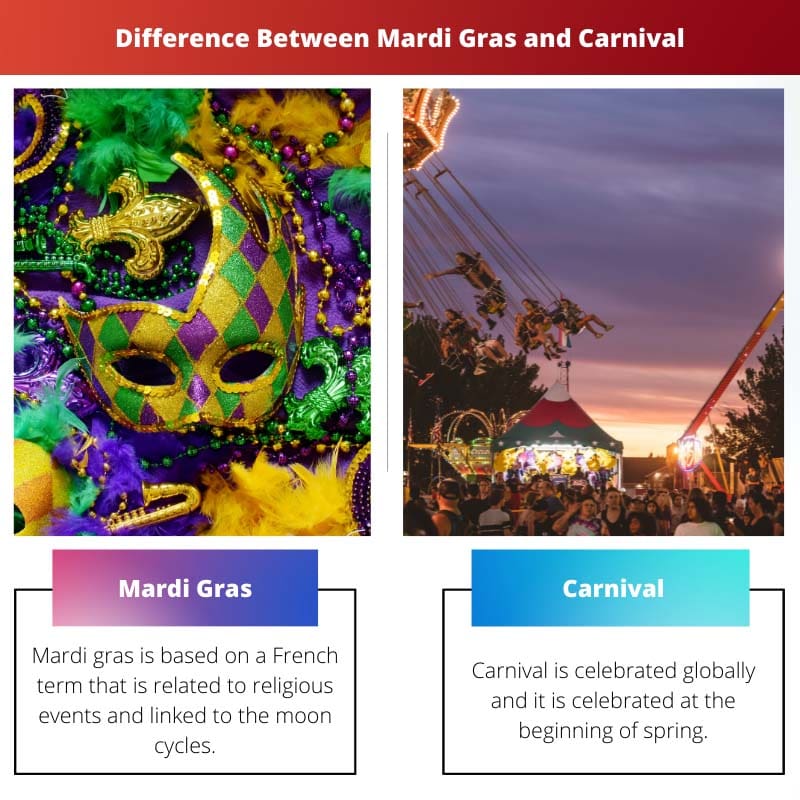Mardi Gras and carnival are global phenomena celebrated around the world.
Mardi Gras is a religious holiday and the biggest party in the world, while the carnival is a festival celebrated in over 50 countries around the world.
Carnival began as a pagan celebration in ancient Egypt. It occurs during the start of the spring season.
The Mardi Gras celebration, which takes place in mid-February, is a major element of the midseason. Parades, performances, feasts, fairs, and celebrations are all part of both festivals.
Key Takeaways
- Mardi Gras is a specific celebration held on the day before Ash Wednesday, while Carnival is a broader festive season that begins after Epiphany and culminates with Mardi Gras.
- Mardi Gras is most famously celebrated in New Orleans, Louisiana, while Carnival celebrations occur in various parts of the world, including Brazil, Trinidad and Tobago, and Italy.
- Mardi Gras and Carnival involve festive parades, costumes, and music, but regional variations in traditions and customs distinguish the events in different locations.
Mardi Gras vs Carnival
Mardi Gras, which means “Fat Tuesday” in French, is a one-day celebration that takes place on the Tuesday before Ash Wednesday. Carnival is a longer and more elaborate celebration that can last for several days or even weeks, depending on the location and begins on or around the Epiphany.

Mardi Gras is associated with Catholicism in the mid-February season, and excursions are quite important. Mardi Gras is a two-week celebration that is filled with excitement.
Although the parade is the main attraction, other aspects of mardi gras include kings, cakes, mighty grass, and a lot of social celebrations.
The biggest parades are held on mardi gras day, the Monday before Mighty.
Carnival is an annual festival that incorporates public celebrations. Street parties, parades, balls, and other forms of entertainment are common examples of public festivities.
Carnival beginnings, the carnival roots of the world’s largest party, have been speculated to be approximately 5000 years ago by the Egyptians and others, with the Greeks being the most likely.
Some festivals were held in ancient Egypt and Greece to commemorate natural and cosmic cycles.
Comparison Table
| Parameters of Comparison | Mardi Gras | Carnival |
|---|---|---|
| Also called | Mardi Gras is also called fat Tuesday. | Carnival is also called Carnaval |
| Type of Festival | Mardi Gras is a Christian cultural festival. | Carnival is an annual festival. |
| Significance | Mardi gras is a celebration period before the fasting season of Lent. | Carnival is the merrymaking and festivity that takes place in many Roman Catholic countries. |
| Celebration | Mardi Gras celebrations include parades, parties, music, picnics, etc. | Carnival includes parades, balls, street performances, etc. |
| Type of Holiday | it is a Catholic holiday. | it is a Catholic holiday. |
What is Mardi Gras?
Mardi Gras is based on a French term related to religious events and the moon cycles. Mardi Gras is translated roughly from the French as Fat Tuesday.
Fat Wednesday is the day before Ash Wednesday, which begins the season of atonement leading up to Easter on the Catholic calendar.
What we know today as mardi gras today is a catholic tradition and celebration where you eat everything you can drink.
The two biggest hosts of this celebration are New Orleans and Rio De Janeiro. During these festivals, thousands of people travel from one location of the party to another.
The party includes cakes, mardi gras balls, street dance, and a whole lot of celebration.

What is Carnival?
Carnival is celebrated globally, and it is celebrated at the beginning of spring. When Alexander the Great conquered Egypt, the ancient Greeks adopted the festival.
The word “Carne” means meat “Vale” means farewell in the catholic calendar.
Carnival involves celebration events such as parades, public street parties, and other entertainments, combining some elements of a circus where people have fatty food before the fast.
Carnivals we’re traditionally celebrated at the end of the winter season to commemorate the arrival of spring and the regeneration of fertility.
Carnival was viewed as the spiritual transition from darkness to light from winter to summer.
As Christianity spread throughout Europe, so did the festivity of Carnival colonization and exported it worldwide.
Carnival has become a truly global celebration where millions of people all over the world contribute millions of dollars to the party.

Main Difference Between Mardi Gras and Carnival
- Carnival is a season of feasting and revelry that began on January 6. The last day of partying before Ash Wednesday is known as Mardi Gras.
- Carnival is mostly linked with Rio de Janeiro, Brazil, while Mardi Gras is connected with New Orleans.
- Mardi Gras includes a party/parade celebration with ornate floats, historic krewes, live bands, and thousands of plastic beads. Carnival loosely translates to “say farewell to your flesh” in Latin (as in “it’s time to give up meat”).
- Mardi Gras was originally a single day during the carnival season, but it’s increasingly used to refer to a period of up to one or two weeks preceding the spectacular concluding celebrations on Fat Tuesday in most areas, particularly in New Orleans.
- Mardi Gras is a religious festival, while Carnival is thought to have been celebrated before Christianity.

- https://books.google.com/books?hl=en&lr=&id=dz1SUIbn3MAC&oi=fnd&pg=PA1&dq=mardi+gras&ots=gluKUqnGQc&sig=fEGDDgxamsT4bjYaR5m_ZwALXEY
- https://www.cambridge.org/core/journals/journal-of-latin-american-studies/article/prehistory-of-samba-carnival-dancing-in-rio-de-janeiro-18401917/3695A00A6CB1BEC895AEE5E35D4C76F2

This is a highly enlightening post covering two of the world’s most fascinating celebrations.
The variety between Mardi Gras and Carnival is clearly explained here. That’s very informative.
I found the historical information provided here to be very interesting.
The detailed comparison of Mardi Gras and Carnival celebrations in different regions provides an in-depth understanding of their unique cultural significance.
I found the cultural distinctions between Mardi Gras and Carnival very intriguing.
This post contains accessible and insightful information. It’s great to learn about the origins and customs of these events.